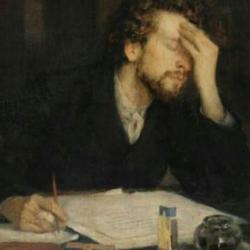Marjorie Garber offers many interesting insights into the themes of Shakespeare?s Comedy of Errors in her recent Shakespeare After All . Here are several of the highlights of her analysis:
1) She points out that, like many of Shakespeare?s comedies, the crisis of Comedy of Errors is provoked by ?an inflexible law?Eand ?the law?s impersonal enforcement.?EThe play opens with the Syracusan merchant Egeon facing death because of his visit to Ephesus, intercourse between the cities having been strictly forbidden by the Ephesian Duke. Though Garber does not make the point, the crisis of law in Shakespeare?s comedies often plays off post-Reformation debates about law and grace (this is most prominent in Merchant of Venice ). Though he is hardly an antinomian, Shakespeare shows that the law is not the solution to the state of the world, but is often part of the problem, an obstacle to human flourishing.
2) Egeon?s ?tragic?Etale of losing his wife and one of his twin sons in a shipwreck sets up many of the themes and leitworten for the remainder of the play: ?Like many other inset tales in the plays . . . it contains, in little, the mythic story of the play to follow. Again, like many other inset tales, Egeon?s story contains a number of terms that, in their resonant doubleness, will haunt the rest of the dramatic action: words like ?happy?E(joyous, but also lucky, or accidental, by chance), ?travel?E(in the period, the same as ?travail,?Esuffering or work), and ?divorce?E(a separation or disunion, but with disquieting echoes of the more specific meaning, a dissolution of marriage.?EConfusions of identity later in the play, for example, provoke the shadow of divorce: Adriana is convinced that her husband Antiopholus is unfaithful (it is actually his twin brother), and speaks of a ?deep-divorcing vow?E(2.2.138).
3) Garber insists that the play is more than a physical, farcical comedy, on the level of a Three Stooges bit. Egeon?s story at the beginning explicitly raises the question of tragedy, and much of the play breathes the air of romance more than farce. Even the mistaken identities, played up for comic effect of course, point to something more: ?modern audiences are also familiar enough with phrases like ?split personality?Eand ?psychological split?Eto see readily that the two onstage characters, who look the same and have the same names, might well be representing twin and conflicting aspects of a single person: the Antipholus who loves his wife, the Antipholus who visits the Courtesan; the Antipholus who is a stranger, the Antipholus who is at ?home.?EThe story of sundering and reunion is a typical romance, but it is also a story of self-discovery and self-knowledge, emphasized by the many moments when one of the Antipholuses (or indeed one of the Dromios [Dromio is the name of each of the identical twin slaves who serve the identical twin Antipholuses?PJL]) declares that he is bewitched or transformed, in search not only of a brother but of what he calls ?myself.?? She summarizes this theme as ?losing oneself to find oneself,?Eand points out that the theme is described in terms of water and sea in parallel speeches by Antipholus of Syracuse and Adriana (1.2.35-40; 2.2.119-129): ?The repetition of this image in the two speeches makes the love of a brother and a mother parallel and cognate to romantic and marital love, while the two sons are also ?splits?Eof their father, one ?inquisitive?Eand wishing to travel, the other remaining at home with his wife.?E
4) Garber notes that Ephesus functions like other green/magic worlds in Shakespearean comedy, a place of confusion and strange happenstance, but ultimately also a place of redemption, reunion, and resurrection. The magic is not always benign, or at least is not experienced as benign: ??Here we wanted in illusions,?Easserts the visiting Antipholus, Antipholus of Syracuse. Despite his sense of ?wonder?Ehe is made increasingly uneasy by what is, to him, an uncanny situation: everyone he meets seems already to know his name; they give him money, invitations, and thanks, and he is convinced he has landed in a place of sorcery from which it is wiser to depart . . . . If dream, fantasy, and transformation are one end of the continuum, then the other end, the darker end, is nightmare and madness: fantasy and loss of contact with reality.?EThrough the confusions, however, clarity comes.
5) The structure of the play is cleverly done. The audience knows, as it often does in comedy, what?s up and does not participate in the confusions of the characters. This stance of superior knowledge permits the audience to laugh at the errors (which means both mistakes and wandering) on stage. But Garber points out that the great secret of the play is withheld from the audience until near the very end ?Ethe fact that the Abbess is Egeon?s lost wife and the mother of the two Antipholuses. Only in her presence are all the characters reunited and identified.
6) Garber notices the frequent Christian references and allusions throughout the play: the presence of an Abbess, for instance, and passing comments like the ?as I am a Christian, answer me?Efrom Antipholus of Syracuse. As she says, ?The Christian overlay of this classical story becomes especially important toward the close when the scapegoated Egeon is pardoned by the Duke rather than ransomed according to the letter of the law.?EIn the same context, the Abbess speaks of the ?thirty-three years?Eof her ?travail?Eto give (re-)birth to her sons, and celebrates it as ?the calendars of their nativity.?EGarber notes the inescapably Christian resonance of the language: ?The word ?nativity?Ewhich of course can mean merely ?birth,?Ebegins to suggest its specifically Christian associations when the Abbess announces the imagistic ?rebirth?Eof her sons (since they have been restored to her); the ?gossips?Efeast?Eof which she speaks is a christening even for godparents (?gossips?E, and the period of thirty-three years she mentions ?Ewhich many editors have seen as evidence of bad mathematics, in adding up the years since the shipwreck ?Eis the traditional age of Christ at his death, and therefore, according to Thomas Aquinas, the ?perfect?Eage that all mankind would ultimately attain after death.?EThese are not merely literary flourishes, since they surround a scene of reunited brothers and restored family harmony.
One is tempted ?EOK, at least I?m tempted ?Eto suggest that the whole story is an extended christening, from the baptismal death of the shipwreck, which separated brother from brother, husband from wife, parents from children; through the travel/travail of the years of wandering/erroring, brother seeking brother like one drop of water seeking another; to the final resurrection and restoration to father and to mother and to brother and to wife. Yes, very tempted. And, this summary of the play makes it clear that even in this early Roman-inspired play, Shakespeare is already writing what I’ve called “deep comedy.” Every loss is redeemed, all is restored, every tear is wiped away; all will be well, and all manner of things will be well.
7) Garber ends her analysis with this: ?Marriage ?Eor the promise of marriage ?Eis the hallmark of dramatic comedy, bondage often the prelude to freedom. The Comedy of Errors maps in clear and recognizable terms a pattern that we will find throughout Shakespeare: losing is finding, confusion the path to sanity; the stern edicts of the law may give way to mercy; and madness and dream offer a path to transformation.?E















